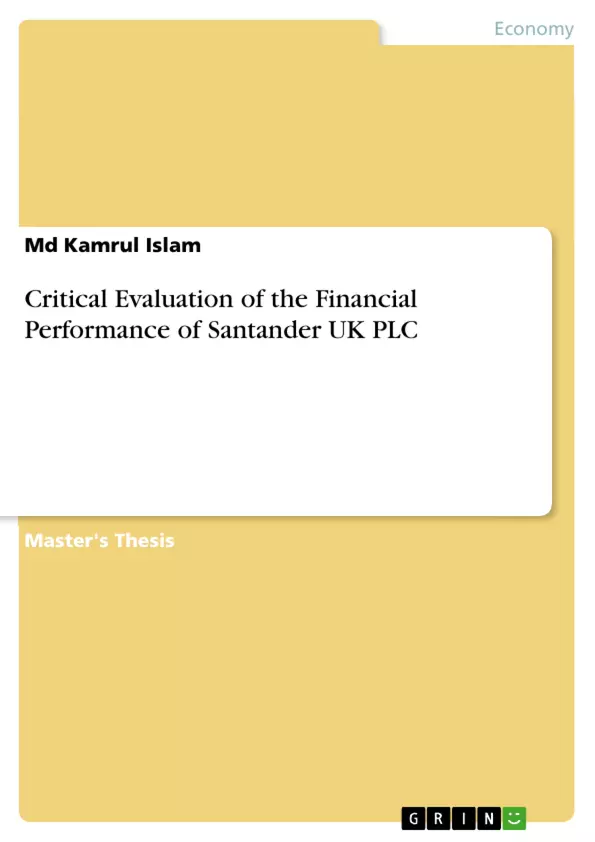The aim of this report is to analyse the financial performances of Santander UK plc to investigate the reasons behind their consistent performance over the last few years whereas other banks and financial institutions are suffering to maintain their profit margin.
Santander Group is a Spanish bank centred on Banco Santander which is being around from 1857. It has been founded mostly in family ownership and now being broadened to become a global bank. In terms of market value, it is the largest bank in Eurozone and also a leading bank in terms of market capitalization. Santander Group entered into the UK through the acquisition of Abbey National plc approved by the courts in November 2004. In 2008 it has also acquired Alliance & Leicester and Bradford & Bingley savings business. Alliance & Leicester plc transferred to Santander UK in January 2009. Abbey Bradford & Bingley and Alliance & Leicester rebranded as Santander. The bank offers a wide range of corporate, business personal, personal accounts including credit products, mortgages, savings and investments. It provides online banking services, including mobile apps. Santander also provides mortgages for Intermediaries through a division of Santander UK plc which is used by the brokers.
The bank is approved by the Prudential Regulation Authority. It is regulated through the Prudential Regulation Authority as well as by the Financial Conduct Authority. It is a member of the UK Payments Administration, Financial Services Compensation Scheme, Bankers' Automated Clearing Services (BACS), the Cheque and Credit Clearing Company, the Faster Payments Service, the British Bankers' Association and the (CHAPS) which is stand for Clearing House Automated Payment System. The reason for the research on Santander UK plc is that the banking is an industry always attracts me to research because it is my desired place to work and I have chosen Santander because of its robust financial performance over the past few years. Since the global recession in 2008 many banks have been limiting their activities and closing down their branches, but Santander has been continuing to expand their business. Moreover, I want to utilize my knowledge and skills I have gained during my MSc program especially Business Analysis, Financial Management and Corporate reporting modules. Some of my favourite theories and models I can implement very well during research on Santander.
Table of Contents
- Introduction
- Study Objective
- Literature Review
- Methodology
- Analysis and Research
- Profitability
- Profit Margin
- Return on Capital Employed
- Return on Asset
- Liquidity
- Current Ratio
- Solvency Ratio
- Current Strategic Position
- Strengths
- Weakness
- Corporate Social Responsibility
- Economic Responsibilities
- Legal Responsibility
- Ethical Responsibility
- Support for Startups to Corporate Business
- Inclusion and Diversity
- Environmental Management
- Carbon Management
- Philanthropic Responsibility
- Central Fund: Learn & Grow and Money Skills
- Helping UK Social Enterprises
- Profitability
- Conclusion
Objectives and Key Themes
This report aims to analyze the financial performance of Santander UK plc and investigate the reasons behind its consistent performance over the past few years, while other banks and financial institutions struggle to maintain their profit margins. The primary objective is to:
- Critically analyze the financial performance of Santander bank from 2012 to 2014 and compare it with HSBC bank.
- Analyze the strategic position that contributes to Santander's robust financial performance.
- Critically analyze Santander's CSR policy and its impact on their performance.
- Examine the key financial ratios and their significance in evaluating Santander's performance.
- Explore the challenges and opportunities facing Santander UK in the current economic climate.
Chapter Summaries
The report begins with an introduction to Santander UK plc, outlining its history, ownership, and business operations. It also highlights Santander's resilience in the wake of the global recession in 2008, contrasting its growth with the decline of other banks.
The "Study Objective" chapter outlines the main goals of the report, including a comparative analysis of Santander's financial performance against HSBC. The "Literature Review" chapter explores the relevant theories and models used for financial analysis and identifies the limitations of such methods. The "Methodology" section details the specific approach adopted for this research, highlighting the chosen financial ratios and their application.
The "Analysis and Research" chapter delves into the core financial performance indicators, including profitability, liquidity, and solvency ratios, providing a comprehensive assessment of Santander's financial health. It also explores Santander's strategic position, identifying both its strengths and weaknesses.
The final section focuses on Santander's Corporate Social Responsibility (CSR) policies, examining their impact on the bank's overall performance. It explores the various facets of CSR, including economic, legal, ethical, and philanthropic responsibilities. The analysis specifically examines Santander's efforts to support startups, foster inclusion and diversity, and promote environmental sustainability.
Keywords
The main keywords and focus topics of this report include: financial performance, Santander UK plc, HSBC bank, comparative analysis, financial ratios, strategic position, profitability, liquidity, solvency, corporate social responsibility (CSR), economic responsibility, legal responsibility, ethical responsibility, inclusion and diversity, environmental management, philanthropic responsibility, and business analysis.
- Quote paper
- Md Kamrul Islam (Author), 2015, Critical Evaluation of the Financial Performance of Santander UK PLC, Munich, GRIN Verlag, https://www.grin.com/document/456098



